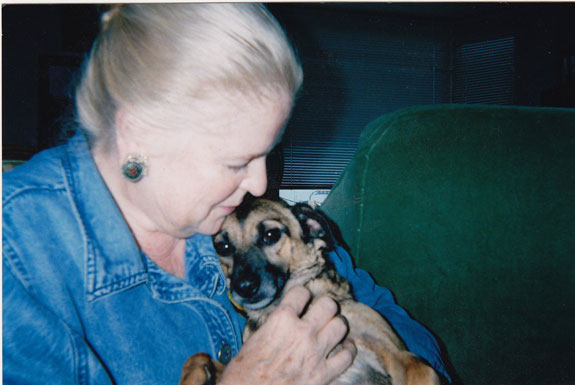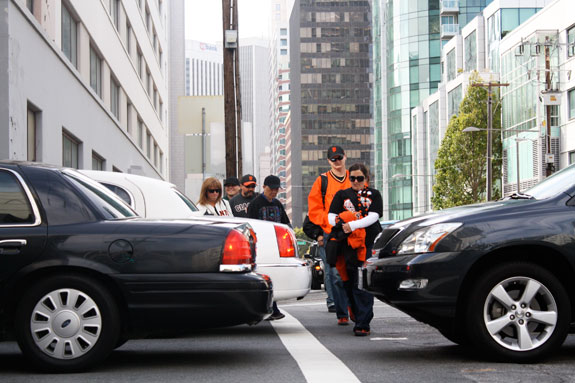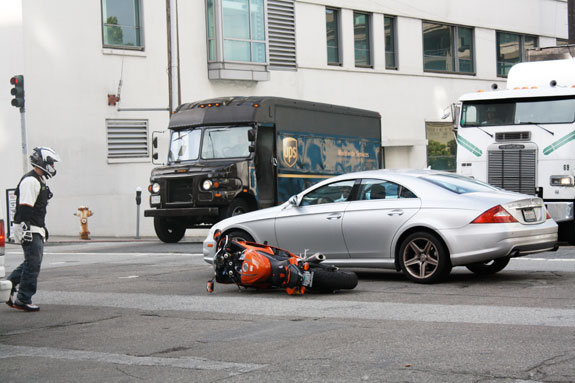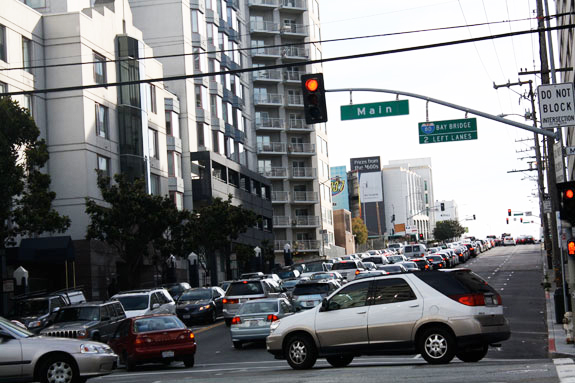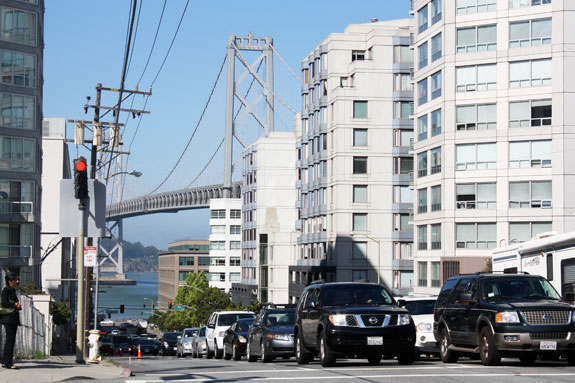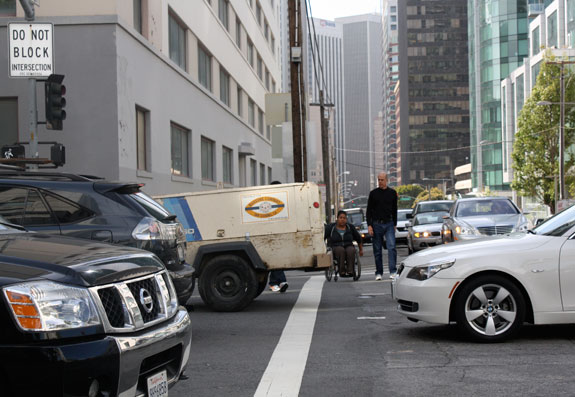
On December 10, 2004, Katy Liddell had just stepped off the N-Judah with a sack of cleaning supplies and was walking to her Portside apartment at Harrison and Main in Rincon Hill, when she noticed a cadre of emergency vehicles surrounding the intersection. As Liddell drew closer, she saw something that horrified her.
"I saw a tarp covering a body in the middle of the street," Liddell recalled. "I found out that one of my neighbors had been hit and killed."
The violent force of a big rig truck had thrown 63-year-old Beverly Kees out of the crosswalk, killing her. Kees, a popular SF State journalism professor who had recently retired, lived across the street from Liddell in the BayCrest Towers. The dog she had been walking was also hit and injured.
"Beverly saved his life. She saw the truck coming and she picked him up," said Debi Gould, Kees' friend and neighbor and owner of the dog who was with her when she died, a rat terrier mix named Harp. As Gould tells it, Kees, who lived two doors down, had been told by her doctor that she needed to walk more. She asked Gould if she could walk Harp one day, and the two formed a close bond.
"She started walking him to the point where he loved being with her, and instead of a couple of times a week, it ended up being every day that I went to work," said Gould, a retired flight attendant who also walks a lot and feels like pedestrians in San Francisco "are considered an inconvenience."
Not long after coming across the aftermath of the crash that killed Beverly Kees, Katy Liddell found out about Walk San Francisco and began advocating for changes at the intersection, along with other residents, including Gould. They formed a committee, organized a petition drive and turned in more than 200 signatures to the Department of Parking and Traffic (DPT). The response was not what they wanted to hear.
"We appreciate the petition that was submitted to DPT's Livable Streets Program and continue to evaluate and prioritize applications for traffic calming. Unfortunately, your location is not a viable candidate for traffic calming measures," wrote the agency's former deputy director of planning, William Lieberman [pdf]. "The current pedestrian issues at the intersection are of a nature that requires active traffic enforcement."
Although the news was disappointing, the committee kept pressing. Two years later, after urging from the office of former Mayor Gavin Newsom, the SFMTA's former lead traffic engineer Jack Fleck sent a letter out announcing a series of engineering changes, including repainting crosswalks and adding pedestrian signals, at several SoMa and Rincon Hill intersections, but nothing was planned for Main and Harrison.
A Mean Intersection
The intersection of Harrison and Main is the kind of place that's so dangerous by design, it's easy to see how drivers can lose their sense of humanity. In one of the city's densest neighborhoods, Harrison serves as a four-lane westbound arterial (there is a fifth eastbound lane) that carries 12,600 drivers daily, most headed to the Bay Bridge. In peak-hour afternoon traffic, drivers routinely speed and block the crosswalk. Since 2003, three people have died there, including Kees, and many more have been injured.
"It's horrible," said Sam Kabash, who owns the corner market. "Drivers come by, they go, and they don't care that people are passing by. There's been too many accidents, too many crashes and too many people getting run over."
On a recent Friday afternoon, many drivers appeared anxious and at their worst, frustrated by the blocks-long queue of traffic inching toward the First Street on-ramp. A man who was knocked to the ground after his motorcycle tripped over a nasty pothole quickly rebounded as drivers flew past him. Giants fans walking to the ballpark were forced to squeeze between cars hogging the crosswalk.
"We're under siege by cars Monday through Friday," said Jamie Whitaker, a pedestrian advocate and resident of the BayCrest Towers, one of several high-rise residential buildings surrounding Harrison and Main. Traffic lightens up at night and on the weekends, but that's not much comfort to Whitaker and other residents who've been lobbying for a "radical re-engineering" of the intersection for seven years now.
"Walking through this intersection every day might make you a little crazy," said Whitaker, standing just outside Habash's market. Not long after moving into the neighborhood from Detroit five years ago, Whitaker started a blog, and more recently has been documenting the ugly conditions on video.
Other intersections along Harrison are just as problematic, including pedestrian crossings at Fremont and at 1st Street, where drivers are led onto the Bay Bridge in front of One Rincon Hill.
Rincon Hill Plan
Rincon Hill was once a forgotten "jumble of freeway and Transbay Terminal ramps," notes this SPUR report, but it's now a 12-block high-rise neighborhood that could see more than 10,000 new residents by 2025. Its streets, however, are not yet ready to accommodate those new residents, whom the city would like to encourage to walk as much as possible.
In practice, developers eyeing future high-rise residential buildings continue to request a high ratio of parking, which means yet more cars in an already congested neighborhood. There are no parking requirements in Rincon Hill and the maximum is one space per two units, required to be built underground, but exceptions have been granted to some developers to build, in some cases, one space for every unit.
"It would be a shame to build a high-rise neighborhood with close proximity to downtown for people who drive to Silicon Valley," said Tom Radulovich, the executive director of Livable City. "We don't need more drivable neighborhoods in proximity to downtown."
The Rincon Hill Plan, passed in 2005, makes the 55-acre neighborhood "a high-priority housing site" because it's so close to the Financial District and has a number of vacant or underutilized parcels. It acknowledges the neighborhood's streets are unsafe and unpleasant for pedestrians. The sidewalks are narrow, the intersection crossings are dangerous, and the noise levels exceed state and city standards. In addition, many walls facing the sidewalk are blank and featureless and there is a general lack of open space.
The streetscape component, currently being revised by the San Francisco Planning Department, envisioned fundamental changes, but it's been sitting on the shelf for a number of years, due to stagnant development that isn't bringing in the impact fees required to pay for the improvements. It calls for "extensive sidewalk widenings, tree plantings, street furniture, and the creation of new public spaces along streets throughout the district."
Some aspects, such as widened sidewalks and landscaping, have already been implemented on portions of some streets, such as Beale and Spear, with the ultimate goal of turning them into living streets. On Harrison, the streetscape plan would widen the sidewalks from 8 to 12 feet, add bulbouts on each block, and narrow the traffic lanes. All the public improvements would cost $26 million. The street components alone would cost $12 million.
Joshua Switzky, a citywide policy planner for the Planning Department, told Streetsblog he is organizing a meeting with residents to unveil the revised streetscape plan and set priorities, given the limited funding. A community meeting has been tentatively scheduled for July 19.
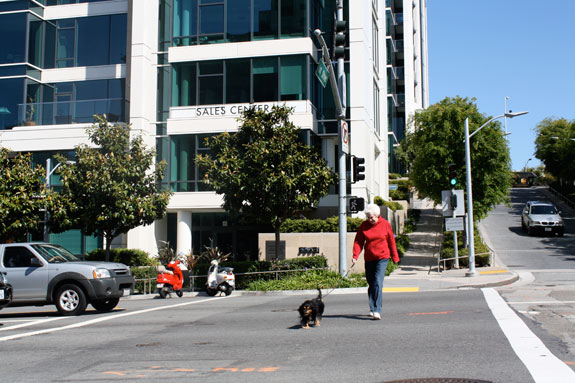
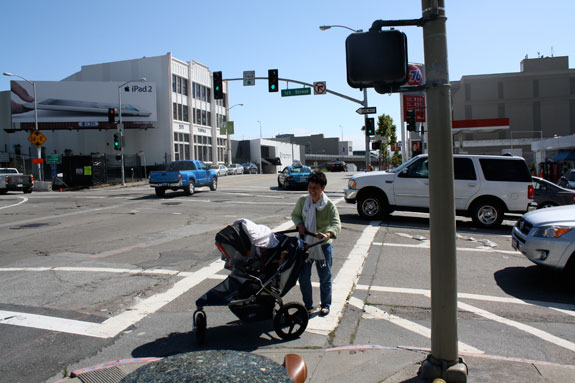
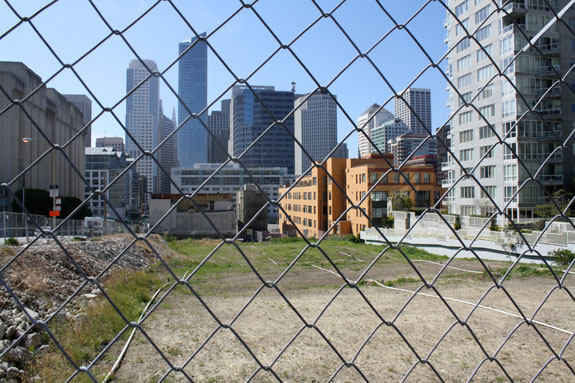
Pedestrian Safety as a Priority in District 6
The advocates working to bring change to Harrison and Main streets have been empowered of late by Supevisor Jane Kim's efforts to improve pedestrian safety in District 6, which has the highest rate of pedestrian deaths and injuries of any district. Most recently, Whitaker has been leading the charge to improve Rincon Hill's streets.
"Jamie has been amazing and it's to his full credit that things are actually happening," said Matthias Mormino, an aide to Kim. In an interview in her City Hall office last week, Kim told Streetsblog that she is working to push the various city agencies handling pedestrian safety issues to move quicker.
"Without a little bit of attention and visibility given to the issue here at City Hall, work just gets shuffled around," said Kim. She pointed out that many city staffers who have advocated for pedestrian safety have been grateful for the attention she's given to the issue.
"It's not like I had to create new ideas and figure out what our priorities are," Kim said. "It's just about implementation. On a certain level, that's easier and more challenging to do." Kim said if voters approve a streets bond measure on the November ballot, she will work to get some of that money directed to pedestrian safety improvements in District 6.
SFMTA Measures
While Rincon Hill's residents wait for streetscape improvements, the SFMTA is finally planning some engineering measures they hope will help at Harrison and Main, thanks to Whitaker's relentless advocacy. According to the SFMTA, the changes include:
- A head start for pedestrians crossing Harrison Street. "The head start will allow pedestrians to cross 4 seconds before any conflicting vehicles receive the green. Thus, pedestrians are given a head start to establish their right-of-way in the intersection, with the intent of making drivers more aware of the pedestrians in the intersection."
- "The flashing red hand will now count down from 15 seconds (currently 9 seconds) for pedestrians crossing Harrison St before going to a solid red hand. After the flashing red hand goes to a solid red hand, there are still about 4.5 seconds before the cross-auto-traffic on Harrison Street will be shown their green light. This intentional delay is extra time that pedestrians can use to complete their crossing."
- Painting white continental crosswalks at the intersection. They feature a ladder design with "white longitudinal lines at a 90 degree angle to the line of the crosswalk," according to the Federal Highway Administration's pedestrian crossings page.
- Pursuing legislation for No U-turns for eastbound Harrison St at Main St. "During our field investigation, we noticed a number of vehicles traveling eastbound on Harrison and making a U-turn at Main St to cut in the queue of vehicles, increasing the number of vehicles in the intersection, trying to get onto the Bay Bridge on-ramp."
In addition, the agency is planning to assign a parking control officer to the intersection. While it's not the "radical re-engineering" advocates had hoped for, "it's a start," said Gould. "I realize there's a lot of red tape involved with City Hall but where pedestrian safety is concerned it's been a serious frustration."
"I'm elated. I'm anxious to see these improvements," said Whitaker. "This is just one intersection in South of Market. There are many more that need help because there's 30,000 more people that have moved to SoMa since 1990, and there's more coming."
